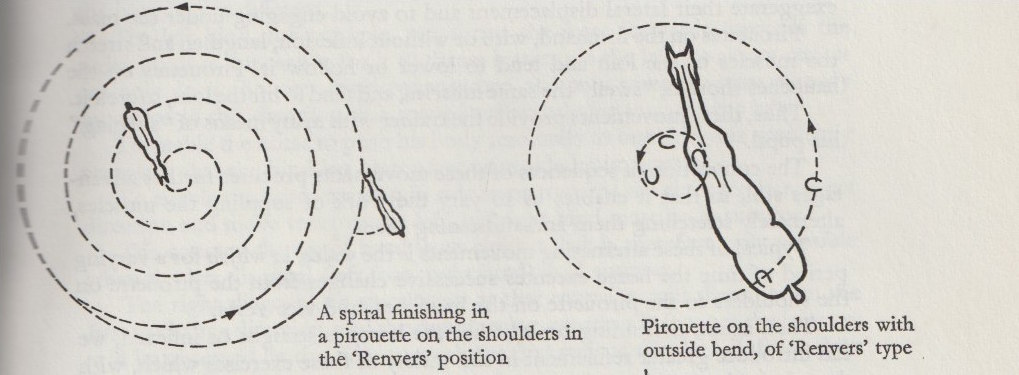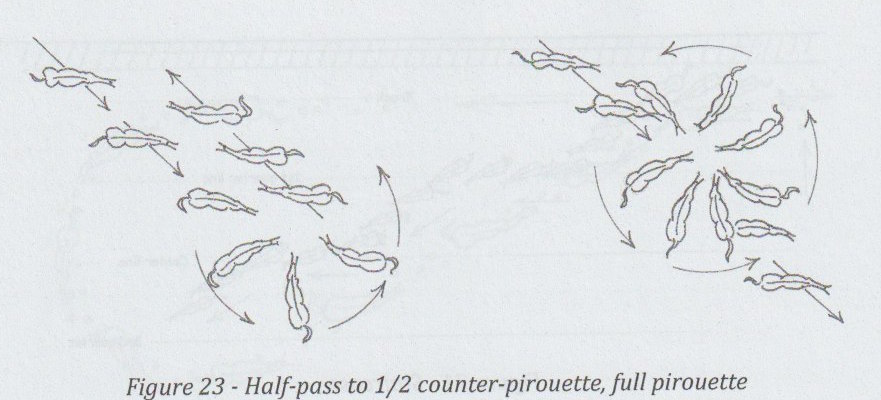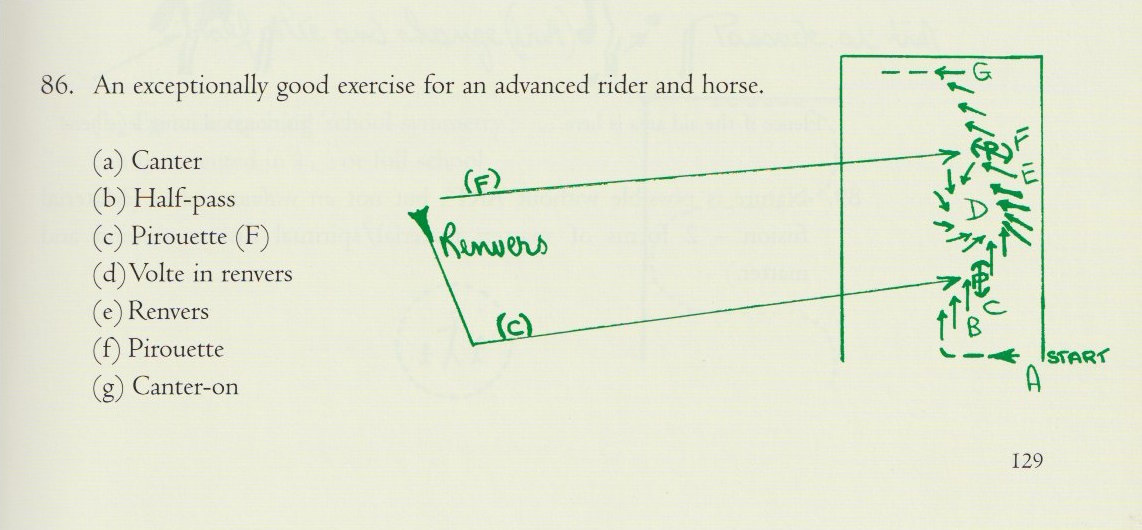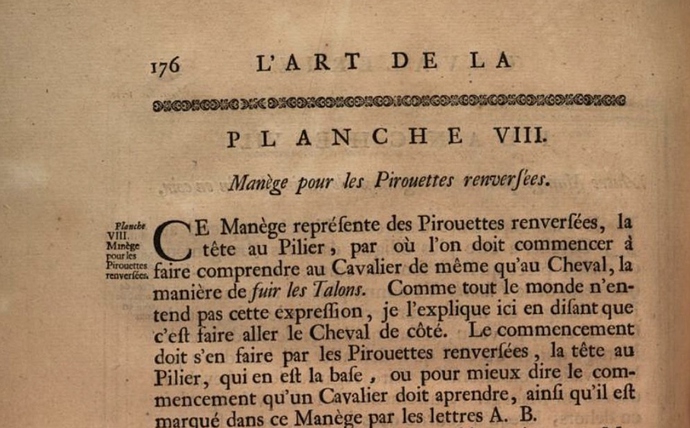The idea is that the position of the body should basically stay the same throughout the entire exercise. So, probably a shoulder fore feeling or shoulders slightly out.
It’s the exercise I call a walking turn on the forehand with the opposite bend (and actually bend, not just flexion).
A good way to introduce it is to put a pole down about 8 - 12’ from and perpendicular to a long side. Walk up one side of the pole. As you near the end of the pole start a ToF and move the horse’s front legs around the pole. Once you’ve got that, do it again changing the flexion. Once you’ve got that change the bend. Voila, a beautiful exercise that makes mincemeat of half passes, makes the rider think, and eliminates a metric ton of avoidances the horse can normally muster when upping the angle game in the half pass 
I do think the pole is fairly important when first learning it - it gives you a path and an obstacle to avoid. You HAVE to keep moving slightly forward to get around it. Once you’ve got the feel of the exercise, you can do it anywhere without the pole.
I guess I’m confused. The video seems to be just a walking ToF into the bend.
Thanks for any enlightenment.
@sascha thanks.
I learned the bow tie a long time ago. We added a circle at E/B, at whatever size is appropriate.
It was taught to me specifically to settle a nervous horse. Repetitive and bendy……
You are not confused. Same way a pirouette can be different diameters such as a “walking pirouette” which can be described as a large circle in haunches in, the reverse pirouette can be described as a “walking ToF” into the bend.
In both cases, the diameter of the circle can be decreased until the turn, in pirouette or reverse pirouette, is done pretty much in place. As the diameter decreases, the difficulty increases. If you look at the reverse pirouette as preparation for a canter depart, it places the outside hind under the haunches and ready to push off into first stride of canter.
Hope this helps.
A pirouette by definition turns about the hind legs - the forelegs describe a larger circle.
A turn on the forehand turns about the forelegs with the hind legs describing a larger circle.
A walking ToF is termed walking because the horse walks through the exercise. It is only done it walk. It describes the forward motion in the exercise as opposed to the near static (merely marking time) state of the front legs in a regular, garden variety ToF.
A working pirouette is NOT termed walking because it is working towards becoming a pirouette and until the hind leg circle actually becomes small enough for the forelegs to start covering more ground and turning around them, it is simply travers on a circle.
Additionally, a working pirouette is not called a walking pirouette because it can be done in all three gaits.
There is no such thing as a reverse pirouette. Please don’t let confused/mis-educated folks confuse you!
I suggest you discuss this opinion with the Cadre Noir rider who had me perform the “reverse pirouette.”
I try to be helpful and answer a question and you come back with a personal insult?
Perhaps I should have used the French term, Pirouette Renversée.
Google is your friend. Here is a video of pirouette and Pirouette Renversée at the canter…and it is even done by a German rider.
You can think of the reverse pirouette as riding a circle in haunches-out (renver) until the front legs make a very small circle.
Here is another video of a reverse pirouette at the walk. It is an exercise to engage and strengthen the hind end and back. In this video you can see how the exercise places the outside hind under the body and ready for the horse to give an elevated canter depart.
Is it called “reverse” only because it is around the forehand rather than the haunches?
Pirouette renversee properly translated means turn on the forehand, not ‘reverse pirouette.’
Sort of, it’s a translation issue 
Doesn’t matter the term if the concept is understood. It is an excellent warm up which loosens the horse’s body. Keeping both shoulders up and feeling the horse lift through his entire body is the big trick of getting the most from it, at least in my book.
Ok.
You can lecture the Cadre Noir on this not me. I am just reporting on my lesson
Has it occurred to you that whomever was translating made the obvious choice instead of the correct choice?
Just because you have heard something translated by someone of high stature in the horse world does not mean they got the translation correct.
Going into a store and asking for ear muffins because you are cold doesn’t make the term correct no matter who told you it was correct or how long you’ve assumed it to be so. (true story - an old acquaintance, shortly after moving to NA from Europe went shopping for ear muffins. Much hilarity ensued and weirdly, they didn’t get all bent out of shape when a lowly shop clerk corrected them)
My late DH was a showjumper from Europe. He always pronounced “bagel” as “beagle” when he ordered a bagel w his coffee. One morning, the nice girl behind the counter he had gotten to know, said “Do you want that beagle in a bag or on a leash?”. Lots of hilarity there, as well. He had a great sense of humor.
Well, my misunderstanding of the “reverse” part of the name meant I did not understand the concept at all. To me, that meant the horse was pushing away from the bend, not into it……
Every translation I can find for Pirouette Renversée is reverse pirouette.
For those who are interested and would like to expand their knowledge. I went to my bookshelf. Here are just a few references…there are more, but these give a flavor of other nomenclature for this movement that is not in American english.
From Juan Carlos Altamirano’s Diccionario Ecuestre (p. 235-no picture)

he describes the movement as “pirueta inversa”…eg., inverse pirouette.
Frome General Decarpentry’s Academic Equitation, (p. 35) he describes the movement as “pirouette on the shoulders.”
From Francois Lemaire de Ruffieu’s book, Divide & Conquer-Advanced Dressage Techniques (p.42), he calls it “counter-pirouette.”
From Charles Harris’ Workbooks from the Spanish Riding School (p.129) he calls it “volte en renvers”…this diagram is the exercise I was working on.
Gaspard de Saunier’s L’Art de la Cavalerie discusses “pirouettes renversées” with diagram of footfalls.

I have other books, but I am getting ready to ride my lesson with the Cadre Noir rider tomorrow and don’t have time to scan my library.
Bonne nuit.
THe bend is reversed also
Don’t isn’t a turn into the bend?
Update from my lesson. Based on this thread, I asked the question about bend and direction of rotation. As a dressage nerd, I was curious.
Here are the answers I got. Again, if you have issues, talk to Cadre Noir. I am just the messenger.
To clarify, in all cases we are rotating the haunches around the shoulders.
Case#1 - The rotation is away from the bend. This configuration he called “turn on the shoulders.” Starting at X, the typical gymnastic would have a bend to right, rotate the haunches around the shoulders clockwise 1/2 revolution, then continue in leg yield to wall.
Case#2 - The rotation is in the direction of the bend. This configuration he called “reverse pirouette.” Starting at X, the typical gymnastic would have a bend to right, rotate the haunches around the shoulders counter-clockwise 1/2 revolution, then continue in half-pass to wall.
The best reference illustrating this exercise is from Francois Lemaire’s book showing the counter-pirouette.
Francois’ illustration shows 1/2 rotation and full rotation…starting at half-pass to counter/reverse in half or full pirouette and continue in half-pass.









